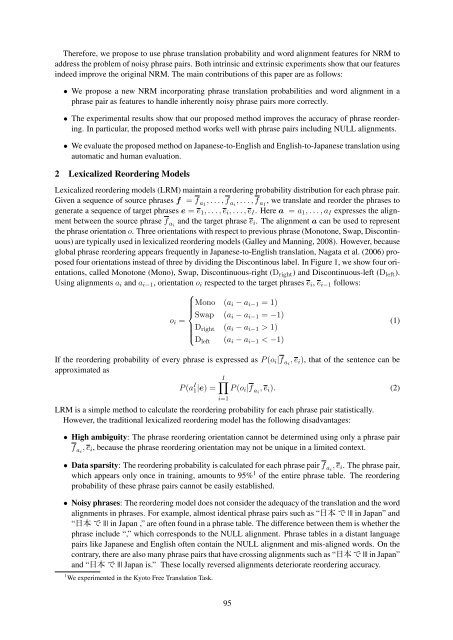December 11-16 2016 Osaka Japan
W16-46
W16-46
Create successful ePaper yourself
Turn your PDF publications into a flip-book with our unique Google optimized e-Paper software.
Therefore, we propose to use phrase translation probability and word alignment features for NRM to<br />
address the problem of noisy phrase pairs. Both intrinsic and extrinsic experiments show that our features<br />
indeed improve the original NRM. The main contributions of this paper are as follows:<br />
• We propose a new NRM incorporating phrase translation probabilities and word alignment in a<br />
phrase pair as features to handle inherently noisy phrase pairs more correctly.<br />
• The experimental results show that our proposed method improves the accuracy of phrase reordering.<br />
In particular, the proposed method works well with phrase pairs including NULL alignments.<br />
• We evaluate the proposed method on <strong>Japan</strong>ese-to-English and English-to-<strong>Japan</strong>ese translation using<br />
automatic and human evaluation.<br />
2 Lexicalized Reordering Models<br />
Lexicalized reordering models (LRM) maintain a reordering probability distribution for each phrase pair.<br />
Given a sequence of source phrases f = f a1<br />
, . . . , f ai<br />
, . . . , f aI<br />
, we translate and reorder the phrases to<br />
generate a sequence of target phrases e = e 1 , . . . , e i , . . . , e I . Here a = a 1 , . . . , a I expresses the alignment<br />
between the source phrase f ai<br />
and the target phrase e i . The alignment a can be used to represent<br />
the phrase orientation o. Three orientations with respect to previous phrase (Monotone, Swap, Discontinuous)<br />
are typically used in lexicalized reordering models (Galley and Manning, 2008). However, because<br />
global phrase reordering appears frequently in <strong>Japan</strong>ese-to-English translation, Nagata et al. (2006) proposed<br />
four orientations instead of three by dividing the Discontinous label. In Figure 1, we show four orientations,<br />
called Monotone (Mono), Swap, Discontinuous-right (D right ) and Discontinuous-left (D left ).<br />
Using alignments a i and a i−1 , orientation o i respected to the target phrases e i , e i−1 follows:<br />
⎧<br />
Mono (a i − a i−1 = 1)<br />
⎪⎨<br />
Swap (a i − a i−1 = −1)<br />
o i =<br />
(1)<br />
D right (a i − a i−1 > 1)<br />
⎪⎩<br />
D left (a i − a i−1 < −1)<br />
If the reordering probability of every phrase is expressed as P (o i |f ai<br />
, e i ), that of the sentence can be<br />
approximated as<br />
I∏<br />
P (a I 1|e) = P (o i |f ai<br />
, e i ). (2)<br />
LRM is a simple method to calculate the reordering probability for each phrase pair statistically.<br />
However, the traditional lexicalized reordering model has the following disadvantages:<br />
i=1<br />
• High ambiguity: The phrase reordering orientation cannot be determined using only a phrase pair<br />
f ai<br />
, e i , because the phrase reordering orientation may not be unique in a limited context.<br />
• Data sparsity: The reordering probability is calculated for each phrase pair f ai<br />
, e i . The phrase pair,<br />
which appears only once in training, amounts to 95% 1 of the entire phrase table. The reordering<br />
probability of these phrase pairs cannot be easily established.<br />
• Noisy phrases: The reordering model does not consider the adequacy of the translation and the word<br />
alignments in phrases. For example, almost identical phrase pairs such as “ ||| in <strong>Japan</strong>” and<br />
“ ||| in <strong>Japan</strong> ,” are often found in a phrase table. The difference between them is whether the<br />
phrase include “,” which corresponds to the NULL alignment. Phrase tables in a distant language<br />
pairs like <strong>Japan</strong>ese and English often contain the NULL alignment and mis-aligned words. On the<br />
contrary, there are also many phrase pairs that have crossing alignments such as “ ||| in <strong>Japan</strong>”<br />
and “ ||| <strong>Japan</strong> is.” These locally reversed alignments deteriorate reordering accuracy.<br />
1 We experimented in the Kyoto Free Translation Task.<br />
95



